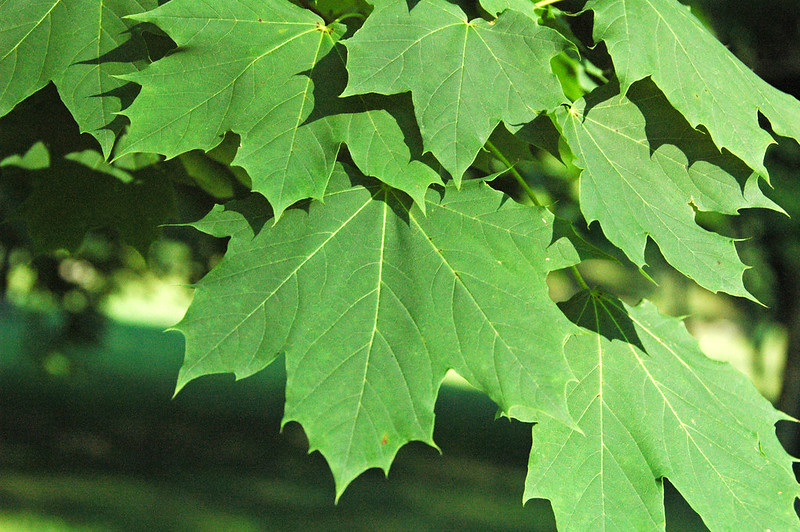This is the first half of a two-part series on Norway maple. The following examines the tree’s habitat, developmental traits, longevity, height, bark, and leaves.
Introduction
Norway maple (Acer platanoides), also referred to as Bosnian maple and plane maple, is a deciduous tree that is native to eastern and central Europe, and western Asia. It was introduced to North America as a shade tree in the mid 1700s. It has since become widespread throughout North America, particularly the United States.
Norway maple belongs to the family Sapindaceae. It is known for its dense canopy and striking red or purple foliage. In its native territory, Norway maple is seldom a dominant species, usually growing as an understory tree. In parts of North America, it has been designated an invasive tree species. It is commonly selected as a planting in urban and suburban areas.
Distribution & Habitat
Norway maple ranges from southern Sweden to Norway, Finland, Belarus, Russia, the Baltic States, Ukraine, and the Caucasus. It also grows in central Europe, though does not occur naturally in the United Kingdom, western France, Spain, the Netherlands, or Denmark. It can be found in the mountain forests of Afghanistan and Turkmenistan. In this range, Norway maple develops most frequently in diverse forests.
Prior to 1683, Norway maple was grown in Scotland at the Royal Botanic Garden. Since its introduction to North America, it has become widely established, frequently appearing in parks, gardens, and suburban landscapes. Across the New England states, Norway maple can be found in forests and wetlands, as well as along roadsides. In Canada, it has colonized a plethora of thickets, hedgerows, and woodlands.
Status as an Invasive Tree Species
Between 1750 and 1760, Norway maple was introduced to the Northeastern United States, where it was widely planted as an ornamental shade tree. Norway maple has few natural predators and diseases beyond its native territory. As such, over time, the species was able to proliferate and spread across much of North America. In some sections of North America, Norway maple has displaced many indigenous tree species, altering the composition and structure of the affected forests.
In an effort to off-set the deleterious effects caused by Norway maple, New York, Wisconsin, and the New England states have classified it as an invasive tree species. In Virginia, Norway maple is considered moderately invasive. Connecticut views it as a potentially invasive tree species. Vermont lists Norway maple as a category II plant. Due to its invasive status in the Northeast, Norway maple has been banned for sale in New Hampshire and Massachusetts.
Developmental Traits
Norway maple forms a broad, rounded crown. Its wood has a yellow-white to pale red hue. It is often wider than it is tall. The tree’s branches can be brittle, and may pose a hazard when rooted close to municipalities, utilities, or residential buildings. It has white, milky sap, a characteristic trait that distinguishes it from sugar maple, which has clear sap. Norway maple exhibits cold resistance down to -25°F.
Longevity
In its native territory, Norway maple can live for up to 250 years. In North America, it typically has a shorter lifespan, living for 60 to 100 years. When planted on roadsides, the roots will often wrap around the tree, and girdle it, drastically reducing its lifespan.
Height
Norway maple is a medium to large sized tree, reaching heights of 40 to 100 feet, and a diameter of up to 5 feet.
Bark
Norway maple has greyish-brown bark, and displays numerous shallow ridges and furrows along its surface. The ridges are small, and assume a criss-cross formation. The texture of the bark differentiates Norway maple from other maples, which typically have shaggy bark.
Leaves
New shoots are initially green, but quickly turn a pale brown. Varieties with red and purple leaves are most common. The leaves generally turn yellow in fall, though they may sometimes be a reddish-orange hue. The leaves have an opposite arrangement, and are palmately lobed, with five lobes each. Each lobe has one to three teeth on either side, but an otherwise smooth margin. The leaves measure 2 ¾ to 5 ½ inches long, and around 9 ¾ inches wide. The leaf petiole is 3 ¼ to 7 ¾ inches in length. If broken, the leaf veins and petioles will secrete a milky sap.
Additional Resources:
https://www.cabi.org/isc/datasheet/2883
If you have any additional questions related to Norway maple, or you are interested in one of our tree services, contact us at 978-468-6688, or Sales@IronTreeService.com. We are available 24/7, and can accommodate any schedule. All estimates are free of charge. We look forward to hearing from you.
Photo courtesy of James St. John CC-by-2.0


